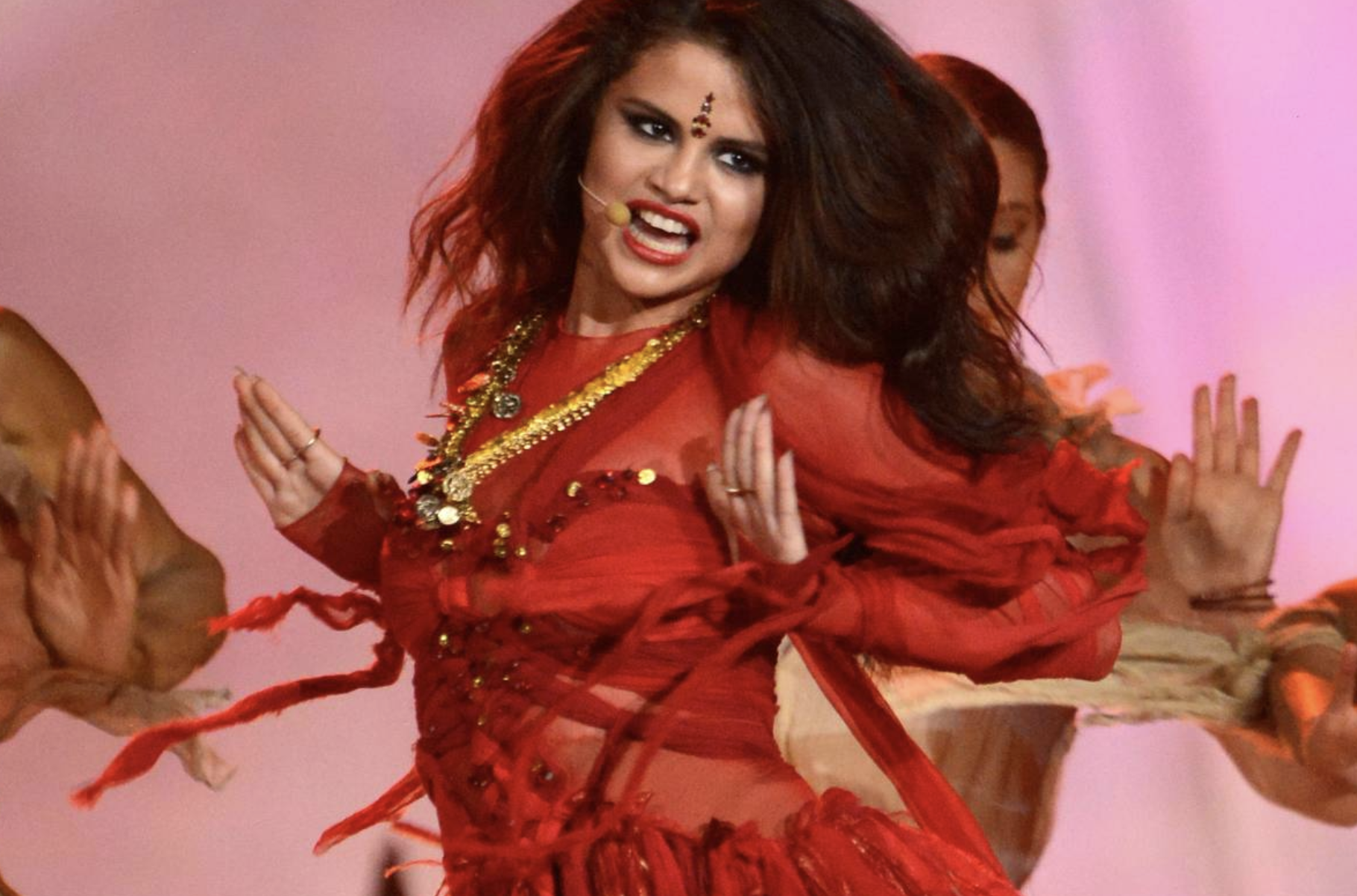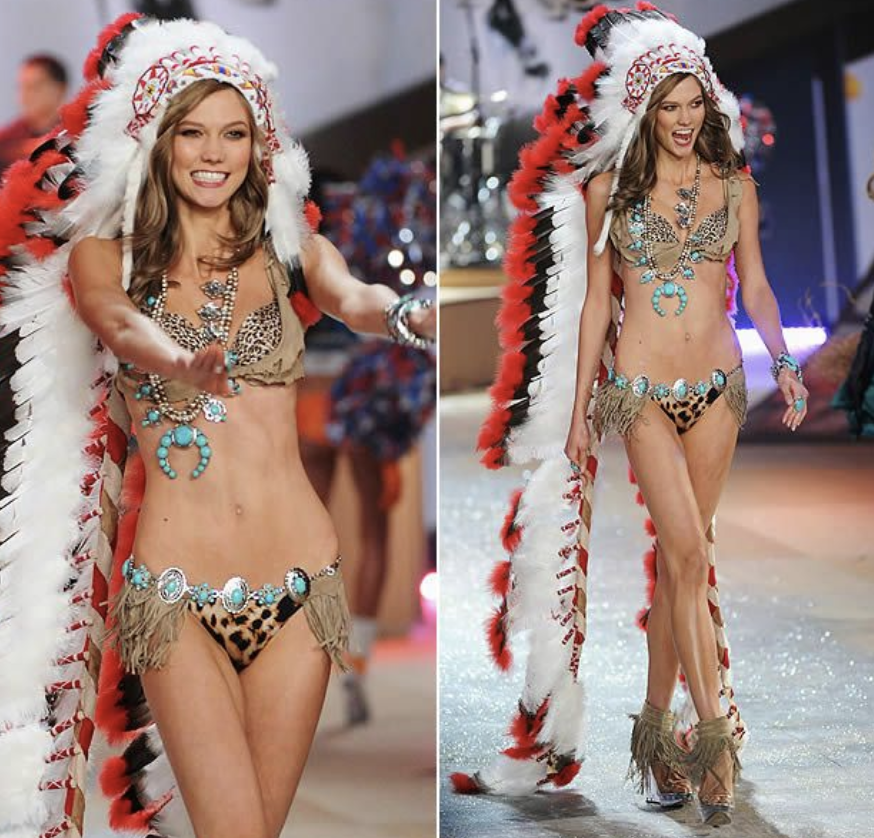Cultural Appreciation & Appropriation in Fashion – Getting It Right
Posted on June 20, 2017 | by Meera Solanki Estrada
Actress/singer Selena Gomez performs onstage during the MTV Movie Awards Culver City, California. (Photo by Kevin Mazur/WireImage)
The Thin Line of Cultural Appreciation & Cultural Appropriation in Fashion — Can We Get it Right?
Cultural Appropriation. The words themselves seem to make us uncomfortable and squeamish in our seats. It’s a highly controversial topic that we hear about in the headlines more and more. There are several reasons why it’s so contentious. According to Nico Lang of the Los Angeles Times “cultural appropriation highlights the power imbalance that remains between those in power and those who’ve been historically marginalized. As such, a member of a dominant group can assume the traditional dress of a minority group for a Halloween party or a musical performance. Yet, they remain blissfully unaware of the roots of such dress and the challenges those who originated it have faced in Western society“. So, does this mean that if you’re not Indian you can’t wear a bindi or sari? Well no — but the line is thin and definitely not straight so we must walk carefully. While I certainly don’t claim to be the authority on this hotly debated topic I do have an informed opinion and perspective and don’t want to shy away from it. On the contrary, I’d like to spark some dialogue and get us talking to each other — because even within our South Asian community of Punjabis, Gujaratis, Bengalis, Marathis, Sri Lankans, Tamils, Pakistanis and so many more — we have appropriation where we want to take some parts without regard and respect for the people and perspectives of those cultures.
Definitions. What Does This Really Mean?
The definition of the term Cultural Appropriation is “the adoption or use of elements of one culture by members of a different culture“. That doesn’t sound so bad? But, you have to look a little closer. When elements of a minority culture are used by members of the cultural majority it can be viewed as wrongfully oppressing the minority culture or stripping it of its group identity and intellectual property rights. In fashion, cultural appropriation allows for a dominant group of individuals to use other cultures in gaining fame or even acclaim for their artistic contributions to fashion, robbing “minority groups of the credit they deserve”. Then there is Cultural Appreciation. While I don’t have a dictionary definition for this, I would characterize it as having a genuine or authentic interest in a culture; in learning about the history (the good and bad), the people and its perspectives and building relationships with members of that culture on the basis of that understanding. If you have an appreciation for a culture then it actually makes it much more difficult to appropriate it because you are more likely able to recognize if your actions will be taken as disrespectful or embraced by the people of that culture.
R-E-S-P-E-C-T Find Out What It Means To Me
Respect is one of the most important yet most violated values when it comes to cultural exchanges. When we moved from England in the mid ’80s, we spent our first few years living in the small town of Brantford, Ontario. We were one of very few non-white families and to say that there was some racism is putting it mildly. My mom would wear a sari and bindi often for celebrations and religious ceremonies. She taught me that I should always wear my bindi for religious functions and the significance of it. But I heard those words “P*ki dot” more than I’d like to remember from snarky little kids, teens and parents alike — and they stung. Fast-forward to Gwen Stefani and Selena Gomez rocking bindis and bras on stage to Beyonce adorned in henna and suddenly my culture is cooler than ever; or is it?
Bindis and henna have historic religious and cultural significance.
All of these female celebs have faced some criticism for their fashion choices of late in regards to appropriation.
Gwen Stefani (Photo by Jeff Kravitz/FilmMagic)
To be honest, part of me does feel irked that growing up my culture was mocked and degraded and then some pop-stars came along and decided they liked parts of it, and suddenly it was cool — well the parts they liked. And while I don’t blame all white women on the face of this earth for those ignorant few in Brantford, I do think a celebrity and the average individual alike who wishes to borrow from my culture has the duty to show it some respect. You have to be mindful of the presentation and usage of the cultural element you borrow. Understand if there is religious significance and if a large number of people express offense, then maybe there’s a reason for that and you shouldn’t do it. Personally I don’t even think its so much the actual adorning of these accessories themselves that have proven problematic; more so the context in which they are worn that makes it feel wrong.
Context is Critical
Context is critical. You have to ask yourself if the context in which you are adopting an aspect of a culture is appropriate. For example, wearing a bindi to a pop-rock concert is out of context. Why? Ask yourself a few questions. Does the concert have anything to do with Indian culture? Does Selena Gomez wearing a bindi in her “Come and Get It” performance have any cultural connection?
But she or anyone else could easily wear that bindi as a guest to a South Asian wedding or a Diwali dinner and many other cultural functions and it would most likely be embraced as a celebration of the culture. Likewise, feather headdresses are all the rage at music festivals. But these are tribal symbols of spirituality and status that don’t have anything to do with these festivals. Its not that its off limits to wear accessories from Aboriginal cultures, but context is critical. Does the context of Coachella have anything to do with the culture you’re borrowing from? If not, then maybe you shouldn’t be wearing that particular accessory. For this reason, some music festival organizers have prohibited feather headdresses. As The Guardian pointed out, it’s anyone’s right to dress like an idiot at a festival, but someone else’s sacred object shouldn’t be a casual accessory. Last week my 5-year old son had his end of year recital. The theme was ‘Music in Different Languages‘. They literally sang in 19 languages and the group musical had 6 styles of dress from traditional Chinese, Korean, East African, Spanish, Indian to Middle-Eastern outfits. All the kids looked absolutely adorable dressed up as you would imagine, but as they came out on stage I couldn’t help but lean forward uneasy and ask myself “is this cultural appropriation“? Very quickly the answer was no. The kids had been learning about these cultures for the past several months. (My son literally had been belting out the Swahili song ‘Jambo‘ in the shower at the top of his lungs for weeks on end). They were learning about the languages of the cultures, about its’ people and the teachers from various backgrounds were also sharing their personal stories with the students in the classrooms. It culminated in a celebration of all the cultures and the clothing worn that day fit in the context of their performance. When I sat back and watched the kids proudly singing in all these different languages I was moved by its splendor. When done right it can be a beautiful display of cultural exchange.
What About Your Friends? Relationships Matter.
Another way to gauge if you’re getting it right is looking at your relationships. Do you have a relationship to the people of that culture? Part of understanding a culture is knowing the different perspectives of the people within it. Its not remote observations, but real interactions, dialogues and friendships. And no, that one “token brown friend” isn’t what I’m referring to. Its engaging with a number of individuals with different viewpoints. No culture is homogeneous in its ideas, and part of understanding a culture is knowing the different perspectives its members have. The reason Amandla Steinberg’s question “What would America be like if it loved black people as much as it loves black culture?” has been cited repeatedly in the discussion on cultural appropriation is because it is so relevant to the conversation. I have many non-Indian friends who love the music, food and vibrant colours of my culture. But I try to make a deliberate effort to show them the not-so pleasant issues in it as well. We have gender inequality, shadism, religious wars, elitist class systems and more. And yes, none of it is pretty to look at but its important to see the whole picture. If you have a relationship with people of a culture you will be far less likely to appropriate it because you will understand the rules of engagement. I am ashamed to say in my early years of university I dressed up as a Chinese doll for a Halloween party. I painted my face white, donned a short black wig and wore a traditional Chinese dress. Looking back I am appalled. I knew that Blackface was wrong, what in my right mind made me think this was okay? It was disrespectful, completely out of context and at that time I didn’t really have any relationship with the culture or people. This is painfully obvious to me now. A few years later I wore that same dress to my best friend’s engagement party. I had spent the year prior in Bath, England on an exchange program and two of my roommates were Chinese. Living together, we learned a lot about each others’ cultures and ended up thick as thieves. To this day we still keep in touch. I remember telling the girls about the outfit I had created, pairing the dress with Indian silk churidaar pants and a chunni along with some antique gold jewelry and heels. They loved the look as did I — that was one of my first love affairs with fusing of fashion. 15 years later I still feel good about that fashion choice. While it wasn’t a Chinese event, it was appropriate formal attire, and I now had an understanding of the culture I was borrowing from, respect for it and relationships and perspectives from the culture to see that what I was doing wouldn’t be viewed as disrespectful. I still have that dress hanging in my old closet at my parent’s place — maybe it will come out if the time and place is right.
Unwritten Codes of Conduct
While the waters may be muddy and grey, there are some unwritten common sense dos and don’ts of how to incorporate another culture into your fashion look.
1. Culture is not a Costume: Don’t dress up as an ethnic stereotype. Someone else’s culture or race—or an offensive idea of it—should never be a costume, a mascot or used as a joke. Remember my Halloween costume. Ignorance is not bliss. Its stupid. Take a page from my book of mistakes.
My Culture Is Not Your Costume @thepoojaproject
2. Artifacts are not Accessories: Karlie Kloss strutting down Victoria’s Secret runway in a fringe suede bikini, turquoise gemstone jewelry, and a feathered head dress had many people upset (and rightfully so) for the lack of respect to Native American culture. A war bonnet like the one Kloss wore has spiritual and ceremonial significance, with only certain members of the tribe having earned the right to wear feathers through honour-worthy achievements and acts of bravery.
Karli Kloss – Victoria’s Secret Show
3. Cultural Influence Does Not Substitute Diversity: Valentino was called out for cultural appropriation during Paris Fashion Week ’15 when white models donned cornrows in their hair. Amandla Stenberg’s offered an eloquent discourse on the real problem at Valentino that year; it was the conspicuous absence of women of colour on the runway. Lack of diversity is an issue for the entire industry, but the problem was particularly visible at Valentino, where the designers talked the talk of multicultural acceptance but quite literally didn’t walk it.
Valentino – Paris Fashion Week
4. Give Credit to Creative Collaborations: If you are sharing values and visions from another culture, you should also be sharing the economics. Designers are beginning to give credit where it is due. For example, Brazilian sportswear designer Osklen used tribal motifs and tattoos for a recent collection and they treated it as a co-branded collaboration. The tribe got royalties from Osklen’s spring 2016 collection as well as a heightened public awareness of their continued struggle to protect land against illegal loggers and environmental degradation. “This is the magic of style. It’s the magic of art. It’s the magic of the design.” said the Creative Director of the collaboration.
Hopefully this is the type of magic we will see more of in the fashion industry. Cultural appreciation and exchanges from another culture can be a force for good. They enrich the available vocabulary for designers, artists and image-makers — even for chefs, filmmakers and architects. Fashion, in particular, thrives on forms of cultural appreciation — but it has to be done right. There has to be regard and respect of the culture from which you are drawing. And even though its fifty shades of confusing grey, with some gentle care, who knows, one day we may even get it right.

















